- 1. Key Takeaways
- 2. Is It Legal to Carry a Dog on a Motorcycle?
- 3. Benefits and Risks of Bringing Your Dog
- 3.1. Benefits
- 3.2. Risks
- 4. How to Prepare Before the Ride
- 4.1. Is Your Dog a Good Fit?
- 4.2. Dog Necessities
- 4.3. Gear to Keep Your Dog Safe & Comfortable
- 4.4. Choosing the Best Motorcycle Seat for Your Dog
- 5. Keeping Yourself Comfortable
- 6. Tips for Easing Your Pet into Motorcycle Travel
- 6.1. Start Small
- 6.2. Choose the Most Suitable Seating
- 6.3. Train Your Dog for Their Own Safety
- 6.4. A Health Checkup
- 6.5. Take Your Time
- 6.6. Read The Law
- 6.7. Identification Details
- 7. Final Thoughts
- 8. FAQs
- 8.1. Are dogs scared of motorcycles?
- 8.2. Do dogs like going on rides?
- 8.3. Are dog helmets safe?
- 8.4. How do I train my dog to like a carrier?
- 8.5. How to make a dog carrier for a motorcycle?
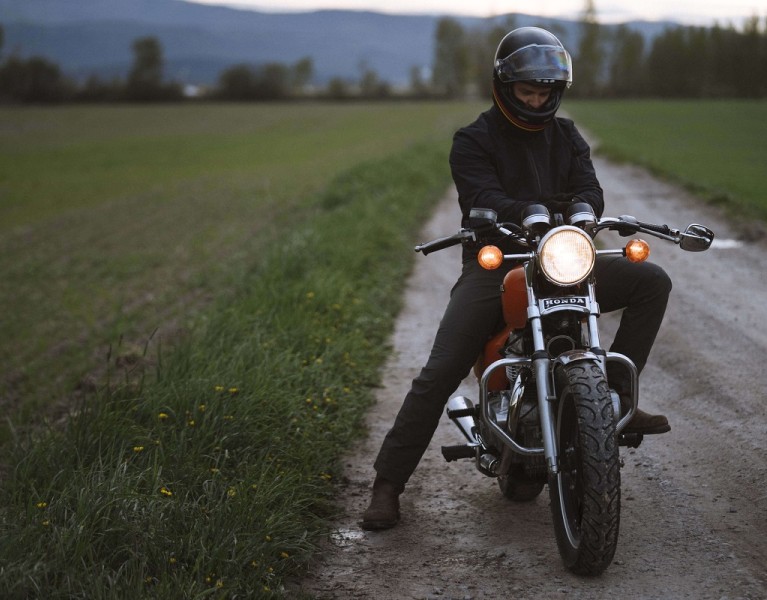
Useful Tips on Traveling With Your Dog On a Motorcycle
Table of Contents [Show]
Both the excitement and pleasure of riding a motorcycle are unmatched. But leaving your furry friend at home when going out for a trip leaves both of you heartbroken. There can be some amount of guilt, too.
So, what if you didn't have to leave your Canis familiaris behind as you discover new roads and states? If you're excited at the prospect of traveling with your dog on a motorcycle, read on!
We've prepared a list of tips on how to take a dog on a motorcycle on your next trip. Learn everything from motorcycle gear for dogs to safety tips and tricks.
Key Takeaways
- Carrying dogs on motorcycles is legal in most states, provided they are secure in their carrier or seat.
- It's crucial to consider your dog's size, weight, health, and personality when introducing them to motorcycle riding.
- Bring plenty of supplies, including pet food, treats, water, and a warm blanket to keep your pet comfortable during long rides and overnight trips.
Is It Legal to Carry a Dog on a Motorcycle?
Laws regarding dogs riding motorcycles vary between countries and from state to state. Traveling on a motorcycle with a dog is legal in most US states. But each state has its legislation regarding dogs riding on open vehicles.
State legislations vary, particularly regarding where the pup can sit on the motorcycle. But most outlaw having your co-pilot between you and the handlebars or on your lap. Most states also require a suitable carrier, cage, or enclosure to prevent the dog from jumping, falling, or being thrown from the motor vehicle.
Generally speaking, it boils down to caring about your furry friend's safety and that of the public. But ensure you are well-versed in your state's or code's requirements to avoid unnecessary citations or even being booked in for a misdemeanor.
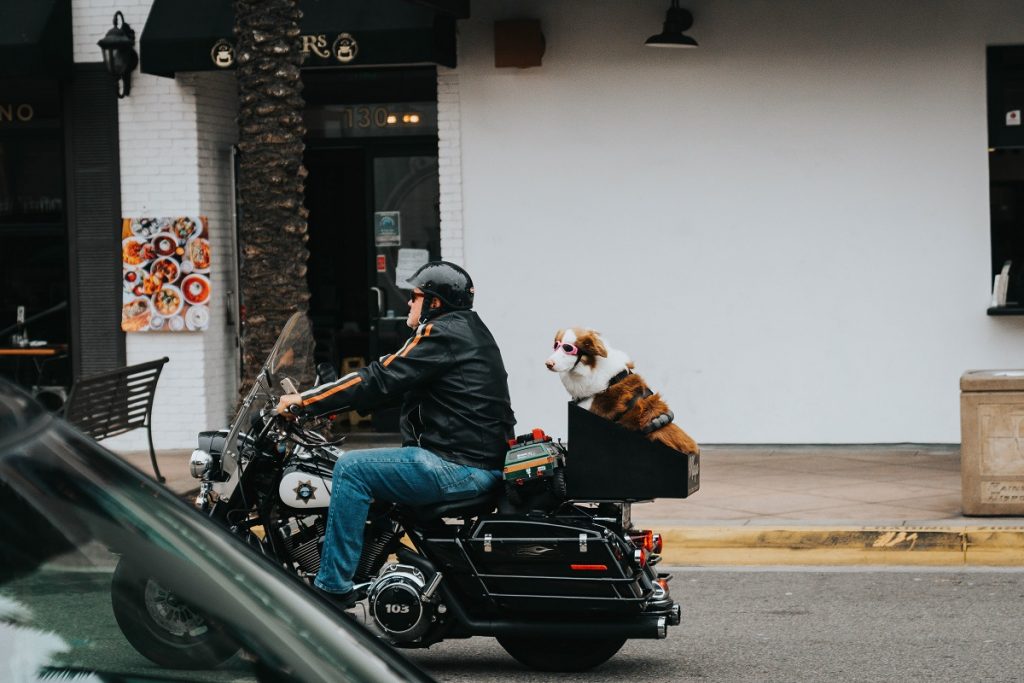
Benefits and Risks of Bringing Your Dog
Carrying a dog on a motorcycle offers plenty of benefits to you and your canine friend. But this type of adventure also has its fair share of risks for both of you, mainly because dogs are not born motorcycle ride-ready.
Benefits
There's less separation anxiety
Like many pet parents, you probably don't have an easy time leaving your fur child behind during long motorcycle rides. Surprisingly, your pooch is affected, too. Dogs are social creatures and typically feel lonely when left alone for too long. If you are tired of dealing with feelings of guilt for leaving your pup at home alone, get them proper rain gear, a suitable helmet, and goggles, and start clocking those miles together.
They are the perfect travel companions
A solo motorcycle ride can be fun. But we bet it will be just as satisfying when you let your pup tag along. The best part about riding with your canine companion is they never question the route you take or your restaurant choice. Plus, they are content with whatever treats or snacks you bring along.
Dogs enjoy adventure
Dogs are naturally curious beings. A bike ride, with all the new sceneries, smells, and sounds, is much more fun than waiting for pets from delivery drivers.
Risks
Falling or jumping off when on the road
The biggest risk for dogs riding on motorcycles is falling, jumping, or being thrown off. And as you can imagine, this can turn really ugly, especially if it happens on a busy highway. We've seen some experienced and really obedient pooches that ride unrestrained. While it looks cool, it's still illegal and hazardous for their safety, yours, and other road users.
Distraction to the rider
It's good to keep in mind that dogs will always be dogs. If your beloved pet is the type that can't stand the sight of a deer or squirrel or the sound of other motor vehicles on the road, they can be a dangerous companion on your adventures. But this can be remedied with proper training and adhering to dog riding motorcycle safety rules.
Weather elements and flying debrisYour dog might look cute as his ears flip in the breeze as you zip past other motorists. But lacking proper outdoor clothing and gear, carrying a dog on a motorcycle exposes them to rocks, dirt, and other flying debris that can cause injury and irritation in the ears, eyes, and throat.
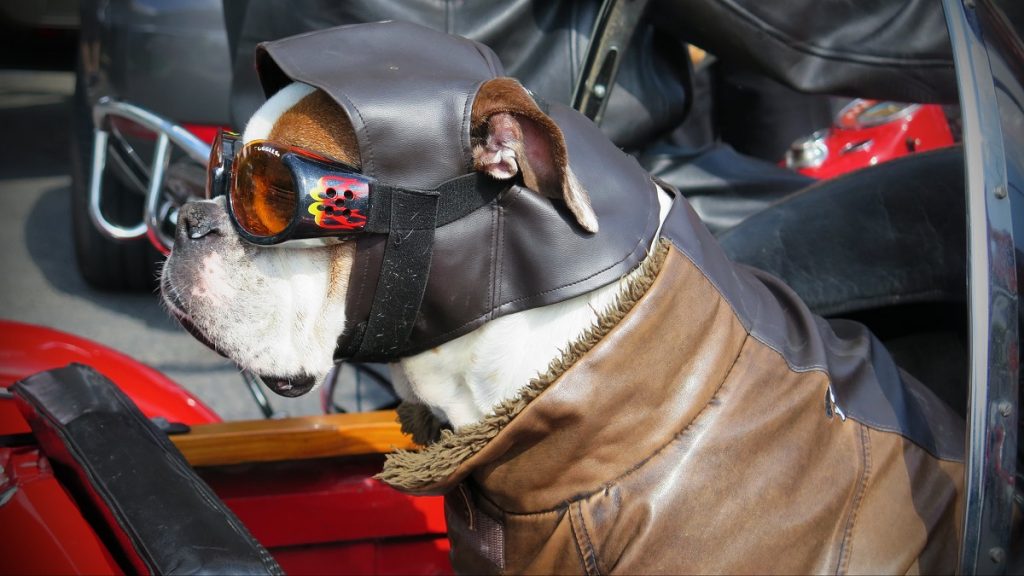
How to Prepare Before the Ride
Motorcycling safely with a dog is possible. As a responsible and caring pet owner, the key is taking all the measures necessary to ensure your furry child is safe and comfortable as a passenger. Here are some vital considerations:
Is Your Dog a Good Fit?
When it comes to learning how to carry a dog on a motorcycle, you must first consider their age, size, weight, health, and behavior.
Age
While there's no age limit, the best time to teach your dog how to ride is when they are young (6+ months). Older dogs may take some time and effort before getting accustomed to the vibrations and engine sound. But the reward of bringing your old champ on your bike rides is worth the effort.
Size and Weight
The size and weight of the dog also matter a big deal. A dog that's too big and heavy, for instance, a 200-pound mastiff, may require a sidecar. And this opens up other considerations, including your bike's ability to take a sidecar and handle the extra weight. If your dog is riding in a carrier at the back or on the tank, be sure their weight doesn't impact stability and steering.
Health
It should go without saying. If your furry four-legged rider shows signs of being under the weather, allow them to skip the ride, especially if it's their first time.
Your Dog's Personality
The success of your motorcycle dog adventures also hinges on your pet's overall personality and behavior. It's very important that your dog is obedient, calm, and well-behaved while on the road to avoid distractions and accidents.
Dog Necessities
Food and Water
Whether you're going for a short journey or taking a week-long trip with your doggie, you need provisions. Start with the basics - food and water.
Even the most straightforward journeys will leave your dog perched, so always have water with you. Nylon travel bowls are great because they squish down to fit into your storage spaces. Canned food and pet snacks are also great for travel.
The amount of food you need throughout the journey depends on the length of the trip. A saddlebag is an excellent way to transport food and keep it safe and dry. Remember to reduce your luggage when bringing a companion to keep your pet comfortable in the carrier. Also, carry a waterproof bag to keep the food dry and safe.
Leash
A leash is essential when traveling with dogs on motorcycles. You'll want to make quick stops for stretching paws and potty breaks along the way. Most states have leash laws, and keeping your dog on a leash prevents him from running into restricted areas or venturing off and getting lost in the woods.
Disposable Water Paper Bags
Lastly, remember to be a responsible pet parent: have disposable pet waste paper bags to clean up. It's a common courtesy and an excellent way to keep the environment clean (bonus points if the bags are biodegradable).
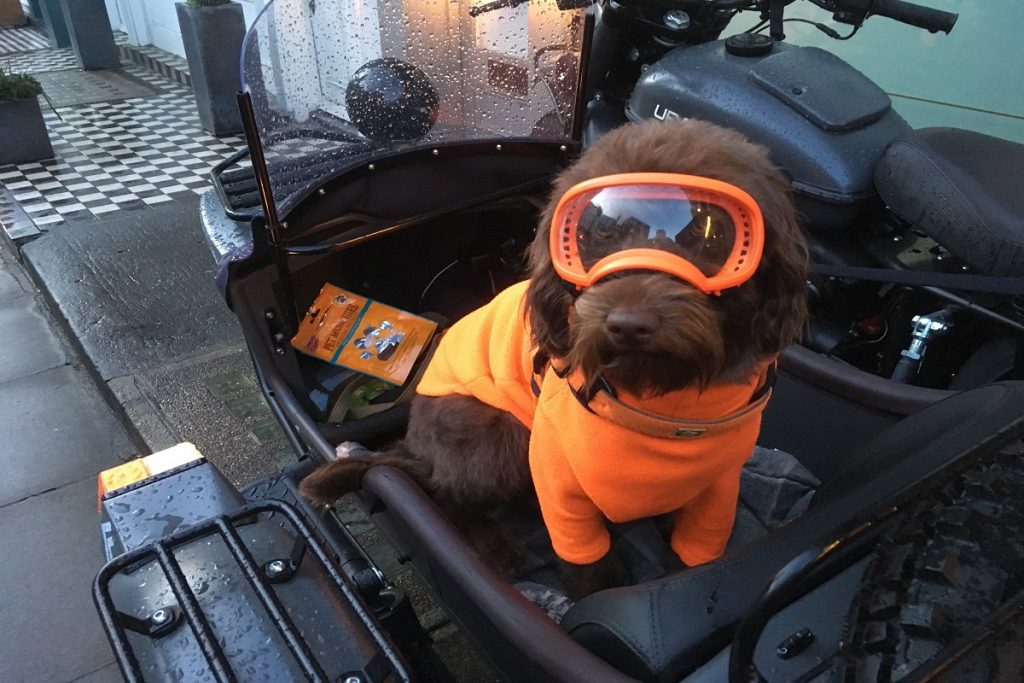
Gear to Keep Your Dog Safe & Comfortable
You always take several measures to stay safe during your motorcycle journey. Goggles, gloves, pants, and the proper boots are critical to the experience. Dogs are no different. They require doggy gear for safety and to enjoy the trip to the fullest.
Harness
A sturdy and comfortable harness is necessary for securing the dog into the carrier or to yourself if your dog enjoys riding on the tank.
Doggy Sunglasses or Goggles
A pair of doggie goggles (doggles) is essential to protect your pet's eyes from debris and bugs. Make sure you find a pair that offers comfort for the jaw and a broad view.
Helmet
A helmet is also an essential item for pet safety and comfort. Not only does a pet helmet protect your dog in a crash, but it also keeps your pet's head and ears warm and safe from the cold.
Cooling Vest
A cooling pad or cooling vest is excellent for extra comfort when it's too hot for a comfortable ride. A poncho or an insulated jacket for dogs is also vital when riding in wet weather.
Ear Protection
Wind damage to your dog's ears is another major concern. Luckily, some earmuffs are designed for dogs. These are over-the-head cups with foam that helps block the wind and some of the noise from the motorcycle.
Choosing the Best Motorcycle Seat for Your Dog
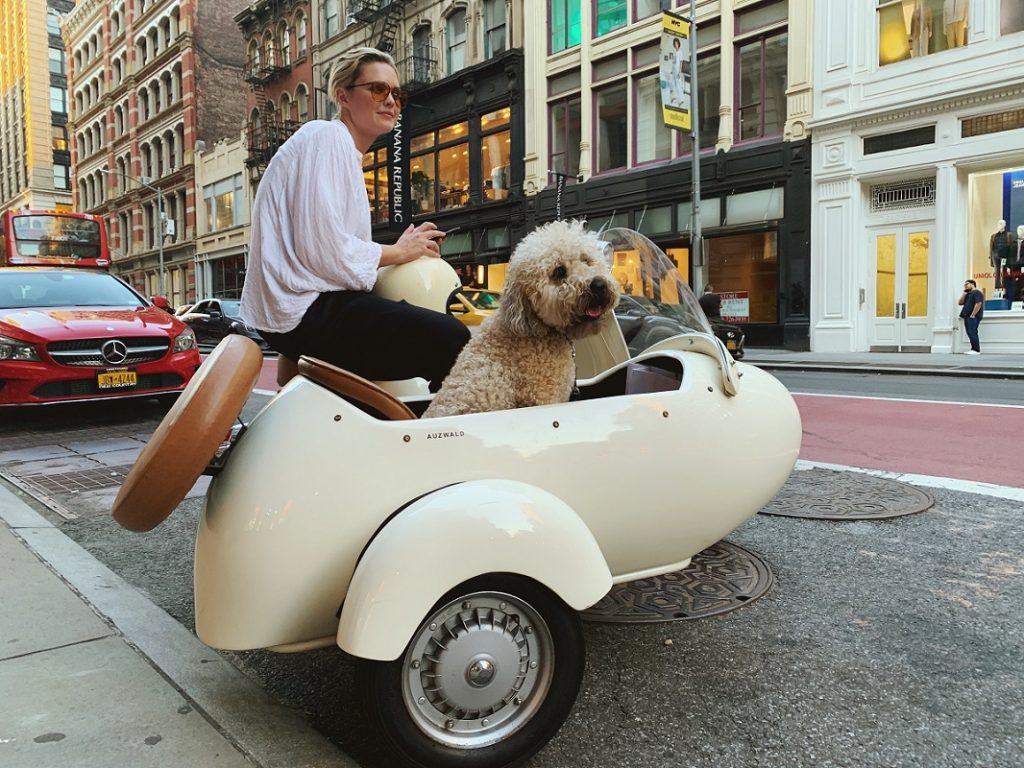
Transporting your dog on a motorcycle should be your first point of concern when organizing a trip with your pet. You want to keep your doggie comfortable, safe, and happy during the journey. Your choice of transport depends on several factors, including your dog's size and the type of trip.
Backpack and Slings
A small pet easily fits into backpacks and slings. This form of transport is excellent for keeping the pet restricted and as close to you as possible. However, it's best to prepare your pet for such travel before introducing them to long journeys. Observe if they're comfortable in the sling and make stops twice as often to allow them to stretch their paws.
Custom Dog Seat
A dog seat is the most common way to bring pets of any size on a motorcycle adventure. Seats come in various sizes and colors and can easily be customized to fit your pet's size and needs. Custom dog seats allow your pet to enjoy the wind in his ears and the scenery as you travel. Owners usually get doggie goggles (goggles) for this type of transport.
Tank Carrier
If the idea of having your small pet exposed to the open air doesn't sit well with you, consider getting a tank carrier. Choose from many different carriers, each made from soft but tough fabrics for your dog's comfort. Pet carriers come with windows for sightseeing and ventilation. Remember to line the carrier for easy cleanup after the journey.
Sidecar
Expanding your motorcycle for your pet's safety and comfort is the most challenging option, but it can be very rewarding for large pets. Your dog enjoys comfort, space, and scenery while riding beside you in his sidecar. It's also the option that elicits the most smiles and photo requests when you stop.
Keeping Yourself Comfortable
Of course, a road trip with a pet requires a confident driver. Ensure you're well-rested and your driving skills are up to the challenge. Your pet will be comfortable and eager to travel with you if you're comfortable and in a good mood.
Choose the right motorcycle travel clothing. During bike rides, you want to keep your skin protected against harsh weather and injury in case of an accident. Durable and comfortable clothing that's easy to layer is the best option for any outdoor trip.
For chilly mornings and evenings, warm up with the men's fleece-lined Burr™ Jacket. Its design ensures comfort without restriction, especially when riding, while the tough fabric protects you from harsh weather. The perfect casual, comfortable, yet adequately warm flannel to keep you going is the Joyrydr™. It's a versatile addition to your biking gear, and it's made for easy layering.
Finish off with a pair of fitting, durable, yet comfortable pants for the motorcycle ride with your pet. Rydr™ is the perfect solution for any bike rider seeking high-performance wear that doesn't restrict movement.
By wearing comfortable, technical, and versatile clothing, you can reduce your luggage load and have more room for your pet.
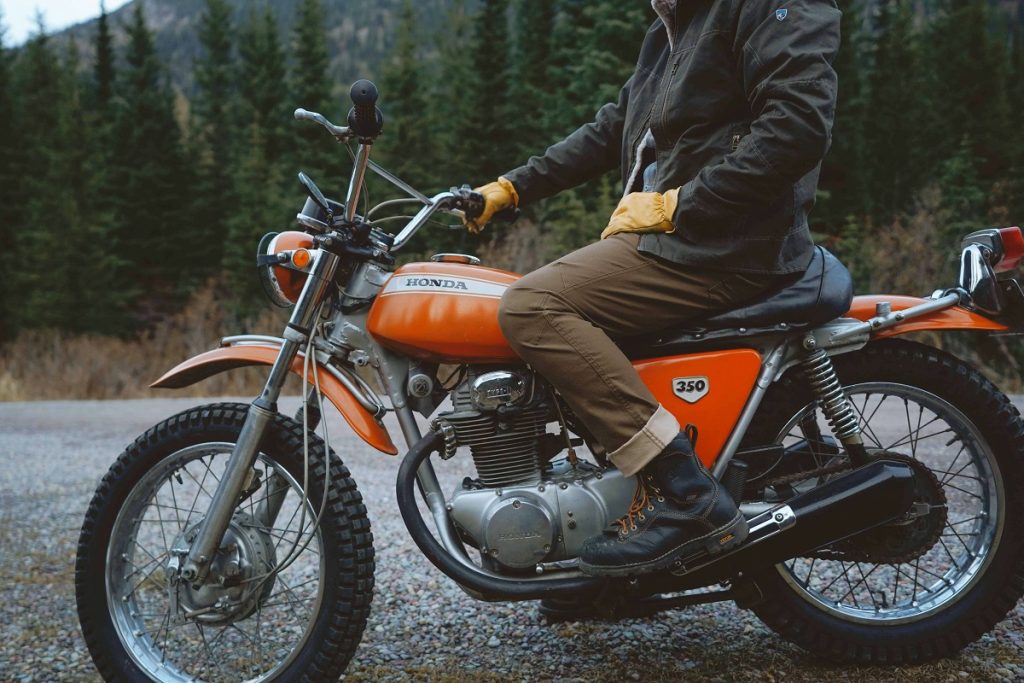
Tips for Easing Your Pet into Motorcycle Travel
Not all pets are used to riding on motorcycles. Some love it, and some are just not into it. When it comes to how to ride a motorcycle with a dog, step-by-step testing is the best way to know if it’s the right fit for your furry companion. Easing your pet into motorcycle riding is the first step to enjoying longer trips together.
Start Small
Try taking short rides around the neighborhood to determine if your dog seems anxious or petrified. After all, you want your dog to enjoy the motorcycle ride as much as possible.
Choose the Most Suitable Seating
Dog seats and sidecars are easy to use with well-behaving and stable pets. However, a more sensitive pet may be safer to place in a dog carrier with certain restrictions. The general rule is to observe your pet's personality and find the best way to work with it for an excellent journey.
A trial period helps you determine the size of your pet relative to your motorcycle and comfort. For example, if you have a small pet, you might find that your dog can fit into a motorcycle travel sling, but they're uncomfortable. In that case, a carrier may be a better fit for your bike ride. Adjust the seating for your pet accordingly.
Train Your Dog for Their Own Safety
The easiest way to ensure that your dog won't get too excited, jump off the bike and run after a distraction is to train them. Although pet carriers are the safest way to keep your dog in place, you won't get very far by forcing your pet into one without any training.
Give them proper training so they feel relaxed, confident, and safe on a motorcycle ride with you. That way, you'll be able to trust them and bring them on a motorcycle adventure with you without second thoughts.
A Health Checkup
Before embarking on a long trip, take your pet to the vet. Have a health checkup just in case to make sure your dog is ready for travel. Update all your shots and vaccines, and groom your pet before the trip, especially when it's hot.
More importantly, check your first aid kit and stock up on medication, bandages, and emergency products for both of you.
Take Your Time
Lastly, no matter how excited you are, it's essential to take your time. Your dog will take a while to adjust to motorcycles, speed, dog seats, long rides, and the general experience of a motorcycle trip. Snacks and treats are vital to reward your dog whenever they do the right thing. After a while, you'll know what they like and don't like, and you'll be ready to go.
Read The Law
Don't forget to review the pet laws in your area. Regulations are essential for pet and rider safety. So if you don't want a run-in with the officials, find out the requirements for dog motorcycle travel.
Typically, you should restrict your dog to prevent sudden movements and keep them safe during the journey. However, the rules may vary per municipality, so it's best to be informed.
Identification Details
No matter where you are with your dog, having their details on them is always wise. Name tags and microchips are an excellent way to provide your dog's name and personal contact details in case the pet gets lost.
With name tags, you can get creative and have customized comments, such as "We're on a motorbike trip, call my owner." Microchips are less distinctive and provide the owner's name and address to anyone that can reach a database with dogs and their owners. The great thing about microchips is that they can't accidentally fall off your dog.
Final Thoughts
Turns out that riding a motorcycle with a dog is a thing. And it's not only legal but also a great opportunity to strengthen your bond as you explore the world together.
If you're a pawrent and a biker, why wouldn't you bring your furry bestie on your rides and enjoy the scenery together?
With the complete list of gear and slow, in-depth pet training, you can unlock a new world of traveling everywhere with your dog for years. And, well, that's twice the adventure!
FAQs
Are dogs scared of motorcycles?
Most dogs react negatively to motorcycles because of the noise, vibrations, and the smell of exhaust. But both young and old dogs can be trained to feel comfortable around motorbikes and even enjoy riding on them.
Do dogs like going on rides?
Yes. Dogs enjoy road trips because they are happy being with you as the parent and pack leader. Also, because they are naturally curious and adventurous, a ride with the people they have bonded with ignites their hunting instincts.
Are dog helmets safe?
Dog helmets are designed with their comfort and safety in mind. The best models have two large holes on top for the ears and built-in enlarged foam for added protection.
How do I train my dog to like a carrier?
The trick to making your dog accustomed to its carrier is making the training process less intimidating. Also, ensure it's a comfortable carrier of the right size for your dog and with enough ventilation.
- Step 1: With both ends open, leave the carrier on the floor where your dog spends most of the time. Allow them to naturally explore the carrier for a few days and use it as their new "house" if they wish.
- Step 2: Make the carrier a fun place by placing their favorite stuff, including treats, inside. This makes them comfortable slipping in and out of the carrier.
- Step 3: Let them explore the carrier with one end closed. Once they get used to this, try zipping up the other end with the dog inside and open it up before they start panicking. Repeat this several times. Ensure you build up a few more seconds of keeping both ends closed with each subsequent attempt.
- Step 4: Leave them inside the carrier with both ends zipped up and walk around the room as they watch you. Next, lift the carrier gently and give your dog his first ride around the house.
- Step 5: Lastly, go out in public.
How to make a dog carrier for a motorcycle?
A quality dog carrier for a motorcycle will set you back about $200 or more. But you can make one at home for less than $60.
What you need:
- A 10.5-gal tough storage tote
- A heavy-duty stainless steel pad eye loop,
- Bolts, nuts, and washers
- Foam safety bumper guard
Instructions:
- Using a dremel, cut a sizable oval-shaped hole at the top of the tote, through which your dog can stick out their head.
- Stick the furniture foam bumper guard around the jagged edges of the top opening to make it safe for your dog.
- Use bolts, nuts, and washers to attach the stainless steel pad eye loop to one of the walls on the inside. You’ll use the pad eye loop to tether your pup securely, so they can’t jump out.
- Lastly, attach the carrier to your motorcycle luggage rack using bolts, nuts, and lock washers.


